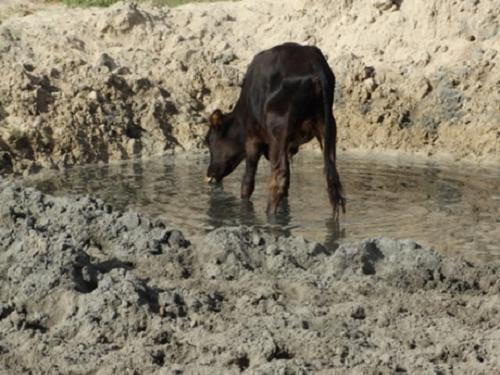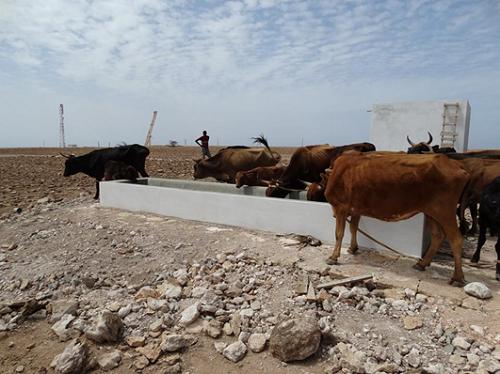Daniel Santos
In 2013, the Salina do Porto Inglês in Maio Island was designated as a Ramsar Wetland Convention site and a protected landscape. The habitat is critical for breeding birds and provides nesting for endangered loggerhead sea turtles. More than 70 local women collect salt and rely on the Salina for their livelihoods. Overgrazing, trampling and faecal pollution by livestock threaten the livelihoods of women and disturb wildlife. The aim of this project is to reduce impacts caused by the unregulated grazing in the Salina to support local livelihoods and improve state of fragile wetland biodiversity.

Cows drinking water in the Salinas before the construction of drinking trough.
The Salina do Porto Inglês is a Ramsar Wetland Convention site, and a protected landscape representing key environmental, cultural, and economic values of Maio Island. It is a complex socioecological system that encompasses habitat for both resident and migratory birds, nesting sites for endangered loggerhead turtles, and supports local livelihoods. For over 300 years the salt was extracted in a traditional way with no harm to the ecosystem by local women passing this tradition from one generation to another.

In recent years a pressure has been increasing in the Salina’s system, with over 120 livestock (cows, goats and donkeys) grazing inside the wetland. The area of Salina is only 400 hectares. These livestock put a large pressure on the wetland. They graze on the scarce vegetation that provides refuge for numerous bird species and trample over sea turtle and bird’s nests. Their faeces contaminate the water and the salt that is collected for local and national consumption. One of the priorities that was identified through the communications with local municipality and livestock owners was to reduce the negative impacts of livestock grazing on biodiversity, and aid local women to improve quality of salt they collect.
The state of the Salina socio-ecological ecosystem to deliver its functions and benefits will be achieved by delivering the two objectives:
Objective 1 To reduce pollution and disturbance caused by livestock in the Salina;
Objective 2 To raise awareness and appreciation of the Salina ecosystem by locals and visitors of the island of Maio.
The following achievements are expected at the end of the project:
The alternative water source for livestock outside the Salina identified to reduce direct disturbance and contamination in the wetland by the livestock. Previous experience in other island suggests cattle stays around the drinking point.
The ecological function of the Salina strengthened and more favourable environment for the species dependent on that ecosystem created. The Salina is the largest wetland in Maio and it provides wintering grounds for thousands of migratory waders. It is also key breeding habitat for loggerhead turtles, harbours the largest breeding population of an endemic cream-coloured cursor and Kentish plover in Macaronesia.
An exhibition about the biodiversity and cultural significance of the Salina organised to generate cultural pride of local people of having such a unique heritage. Salt extraction has been used for over 200 years in Maio to preserve fish and meat and as a valuable export good. Today salt extraction is still an important source of income to local families;
Increased participation of the Salina Women Cooperative in awareness raising activities will raise their confidence and professional pride as salt collectors. The participatory learning with an involvement of local youth and site visitors will remind everybody the importance of sustainably used natural ecosystem and serve as a good example for replication.